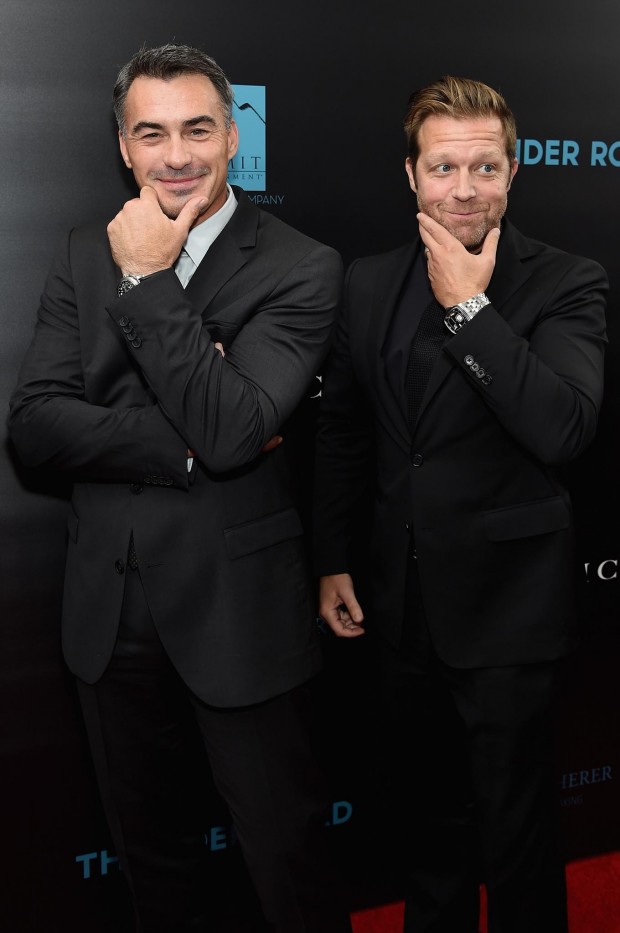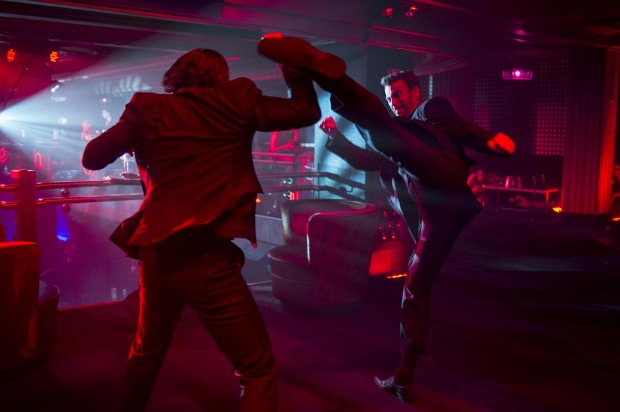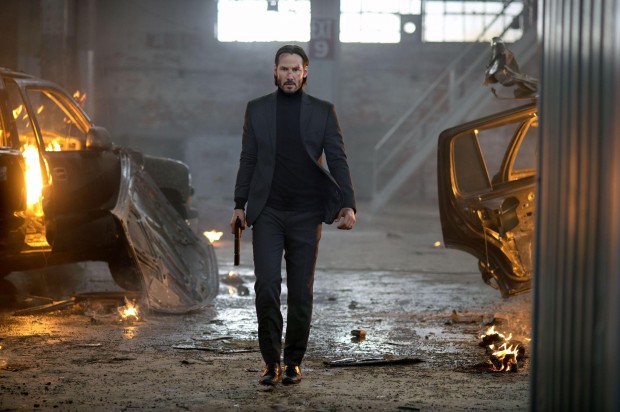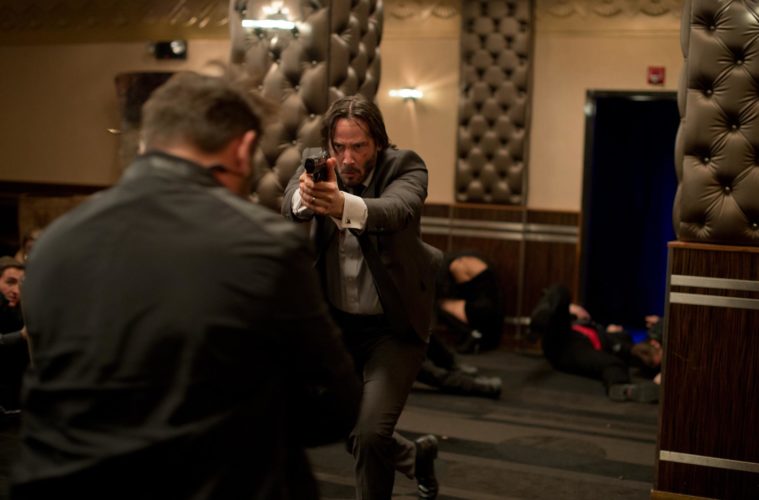As my review can attest to, I’m looking forward to not only watch John Wick again but also see how the film hits with general audiences when it arrives this weekend. The actioner stars Keanu Reeves as an ex-hitman who is crossed by the son of his old employer. When everything is taken from him, he decides to seek revenge in the only form he knows: mowing down bad guys in glorious action. The film is deceptively smart, has a slick presentation, and some genuine heart behind it.
During Fantastic Fest I had a chance to sit down with stars Keanu Reeves and Adrianne Palicki, but up first is my interview with director Chad Stahelski and producer David Leitch. While I personally would like to give them co-director credit in my introduction, the DGA didn’t feel the same. During our interview we touch on that briefly but we really delve into their joint background as stunt coordinators and second unit directors and just how they view action sequences. It’s fascinating to hear Stahelski in particular expound on the fact that most films, even big-budget blockbusters, rarely have any semblance of prep time for action sequences which is part of why they are so disjointed and chaotic on screen. Not so in John Wick, and they explain why as well.
They also reflect on why Keanu sounds like one of the best people to have in your corner as first-time directors, which Stahelski and Leitch surprisingly are. Additionally, we talk about the unique and cool way they stylize the subtitles and you will learn the reason behind it and the influences. Overall it is an absolutely spoiler-free interview that I am particularly proud of and hope it gets you excited to see the action up on the screen. Enjoy the full conversation below and be sure to stay tuned for my other two interviews arriving later this week.
The Film Stage: So, I talked to Keanu Reeves and he was telling me about the Director’s Guild of America and their ruling on you all not getting joint director credit. I don’t want to talk about it too much because I know that was probably an arduous process for you all.
David Leitch: We can talk about it a little bit.
You want to talk about it?
Leitch: Yeah, briefly. Look, as longtime members of the DGA, it was kind of disappointing that they didn’t want to allow us to create a project together in a formal way under their banner. But we went on and collaborated how we were going to collaborate anyways and it’s our movie and we’re proud of it. If the DGA doesn’t want to recognize co-directors then that’s their prerogative but we’re going to continue to make movies together. We’ve been making action together for almost 20 years so it doesn’t really change. The titles don’t change it for us.
Chad Stahelski: Yeah, we’ve pretty much said that in the first meeting when we told them we wanted to co-direct. We have a relationship with the DGA and that’s going to continue because that’s our business. We just hope in the future that they can recognize that when we collaborate together that we would like to be recognized together.
Leitch: Or at least listened to.
Stahelski: Yeah! Let us give the pitch.
 The stylized subtitles are a nice touch, whether you were emphasizing certain words or frame it so that it would skip over a character so it didn’t overlap them in a tight space. It’s so cleverly done and it’s such a small touch. It almost seems like you guys were bothered by the fact that most people don’t stylize them. Where did that inspiration come from?
The stylized subtitles are a nice touch, whether you were emphasizing certain words or frame it so that it would skip over a character so it didn’t overlap them in a tight space. It’s so cleverly done and it’s such a small touch. It almost seems like you guys were bothered by the fact that most people don’t stylize them. Where did that inspiration come from?
Stahelski: I think it had to do with tone. Most people use subtitles to get across information or do what they are there for, translation. We needed hints with tone. The music. The ultraviolence. Subtitles. You’re in a graphic novel. You’re in a story. We’re telling you a story. We’re not showing you a movie. We want you to enjoy it and I think that helps. It puts you at ease to know that you can relax and just watch this.
Leitch: Yeah, it was all about defining the tone and it was just one tool that we used. I think we’re a fan of it. We had seen it before but very rarely.
Stahelski: Tony Scott had done it for Man on Fire. So we liked that. “That’s a neat little idea. How else?” We were a fan of like Quentin Tarantino‘s Inglourious Basterds and stuff where you have them translating three or four different languages. These are straight subtitles, but we wanted our cast to speak a few different languages. We wanted the subtitles to be part of the story. You look at comic book frames, we’re fans of Frank Miller, James O’Mar and stuff and they play with dialogue, too. It wasn’t just regular bubbles. You put the dialogue and the storytelling in the same thing so you didn’t know if you were getting subtitles or story text or whatever. I think Dave came up with it first. “Let’s use it as if it were just story text, not just subtitles.”
With your background as second-unit directors or as stunt coordinators, I have to say that I’m so appreciative of the fact that you guys used multiple cuts during action sequences, but you keep things in frame. Every cut seems to be a better angle at it instead of trying to hide some of the action. So many blockbuster films today use the quick cuts almost for dramatic effect to even getting away from showing the action on screen.
Stahelski: Action, at least for us, you have talent or you’re trying to do something. If you’re trying to do genre action, you want people to see what you’re doing. Martial arts being the example. Fight scenes or technical things. It’s about showing. It’s not about hiding. Unfortunately, in most blockbusters today, they try to hide more than they try to show. Or they try to infuse, “WE GOTTA MAKE IT MORE ACTION-Y! WE GOTTA MAKE IT FASTER!” So, to make it faster you go with a longer lens, you go tighter, and you move the camera a lot. Granted, it does give a sense of frenetic energy but again, our big thing was for our whole career, it’s just like: human talent. You don’t go on YouTube to watch GoPro stuff of somebody’s face and you shake it around. You want to see the kid go up and do the parkour move. You want to see the surfer ride the big wave. You want to see it. Why are you so impressed by it? Because you see it! It’s a human being doing something cool. Like, when you see Keanu Reeves go through five guys, that’s Keanu Reeves going through five guys. He’s doing Judo and he’s doing Jiu Jitsu. He’s doing it. Why does everybody like him? Because it’s Keanu Reeves doing it. Why would we try to hide it? We have a phenomenal guy that put in a lot of work. Much like what we demand from most of the cast. From our stunt teams and stuff. You have talented people doing good stuff.
Leitch: There’s an example we always talk about and it’s the Ong-Bak factor. The Tony Jaa factor. If you look at Tony’s first movie and the camera is on sticks, he comes in, kicks a guy in the face, and everyone goes, “what the f***?”
Stahelski: That’s it!
Leitch: Why? Because Tony’s awesome. The performance is awesome. It doesn’t matter where you put the camera. You don’t need to cheat it. So we strive for that in our performances from our actors.
Stahelski: And I’ll ask, right now, what’s your favorite fight scene? Last five years?
Last five years? I’ve got to say some of my favorite recent ones were from this film called Sleepless Night, a French film.
Stahelski: Yeah, I remember. Which sequence?
The one in the kitchen.
Stahelski: Okay, give me five moves out of that fight.

Oh, wow. Well, I don’t know but some of them were MMA stuff, which I know is a loose-knit term for basically saying I don’t know but there were holds and there were throws.
Stahelski: That’s what we’re getting at. As choreographers, you have to pay attention to that stuff. You can choreograph a hundred great moves, but what do you remember about it? You don’t remember the moves. You remember the vibe, the energy. The character in it. You can talk about The Matrix all day long, but if I asked you five moves, you’re going to give me Keanu dodging bullets, you’re going to give me Carrie Anne Moss suspended in air. You’re going to give me moments. Characters. Shots. So with John Wick, maybe you don’t know his exact gun moves, but you know it was Keanu and you know you liked them.
Yeah.
Stahelski: That’s the interesting thing about it. If you take it one more notch down and you start shaking things around, you start hiding stuff, what are we leaving you with?
Leitch: It becomes this impressionistic thing. It becomes this idea that there was a fight.
Stahelski: I LOVED IT! I DON’T KNOW WHAT IT WAS. I THINK IT WAS A FIGHT. IT WAS GREAT! Ahhhh!
Leitch: I’M GLAD IT’S OVER!
Stahelski: You know, in the last Captain America, you actually saw one of our guys choreograph that. It was like, at least you saw stuff and I think the Russo‘s did a good job.
Leitch: That’s why there was a huge response to the action.
Stahelski: It wasn’t like the first one where you just thought you saw something. You actually saw something. And I think that’s a big thing. That’s the thing with a lot of the big blockbusters. You really think you saw something good. You think you did. [Laughs]
Do you get that kind of feedback from actors?
Stahelski: Oh, all the time.
They can tell the difference between what kind of time and energy is being put into things?
Stahelski: You have to remember, in the movie process, general audiences just think that because it’s a hundred million dollar movie or it’s this blockbuster that you’ve had six months… “Oh my God, everybody is training like in The Matrix!” That is not true. Very rarely do we get any prep. Even on some of the biggest Hollywood movies, you get a couple of weeks or you’re putting together on set. That sounds absolutely ridiculous because you think after that level of investment and financing, you’d have all the prep you need. That’s not true. Actor’s schedules, rehearsal times. It takes a lot. You’re asking a normal human being, a cast-member, no matter what level they are. Whether it’s Iron Man or Neo or Jason Bourne, they’re regular people. Now you’re asking them to perform at an extraordinary level with no training. Or they give them to us and they’re given six weeks. What person do you know that can go into any gym in six weeks and become super human? Our stunt doubles and our stunt people are like professional athletes. Some of them are the best in the world. So how do you get that? It’s not that easy to get great performances. What you do is if you find the gold ones, you get a Matt Damon, a Keanu Reeves, or someone like that, who puts in six months or four months of hardcore, living the life. And in the down time, Keanu is always doing something. It’s not waiting for the role. He’s preparing for a role he hasn’t even found yet. That’s a huge difference. So when you get one of those? You ride the wave and you show it off as much as you can.
It is a unique point in Keanu and the two of your careers because he is coming off of his feature directorial debut and you are making your own. I asked him if he gave you a tip and he mentioned that during the edit, to put it up on the big screen. What other gems did he give you about being a first-time director?
Leitch: He had a lot of sound advice. Speaking of sound advice, sound. He was really…
Stahelski: Big on sound.
Leitch: He had recommendations of people to use, and experimenting with sound. He was collaborative in our choice of music. Finding the right composer. He let us go in a lot of times.
Stahelski: Never obtrusive but always there to support. I think his biggest thing is that Keanu, having come from being a director before, he stepped up and became a department head. Which is interesting. We’ve worked with a lot of actors through our second unit career but never in this capacity. Keanu kind of took it upon himself to be, instead of the production designer in charge of the look of the sets, the director of photography being in charge of the lighting, Keanu became acting department head. He would go and welcome Willem [Dafoe] and he’d sit down with Willem and they’d sit down with Ian [McShane] and and Alfie [Allen]. He really ran his department. He would be like, “Look, Ian has a process.” He would do the intros. He was always going out of his way by not managing the cast but helping us through being the liaison between us and the cast and what made people feel comfortable. Maybe they’re process is different. He was very, very good with keeping us informed. Helping us through some of the stumbling blocks that most first-time directors make.
Leitch: And I’d say the story development and the character development. That was a long process.
Stahelski: He’s big on prep. Big on prep.
Leitch: So four or five months of analyzing the script. Talking through it. John Wick’s character. Who is John Wick? Really taking control of that and guiding us in what he wanted to perform and what he thought John was so we could execute it. It was collaboration.
Stahelski: He was uber detailed with us.
Leitch: It wasn’t like we instilled this John Wick on him. He’s John Wick and we wanted to make sure we helped him deliver that.

John Wick hits theaters on Friday, October 24th.

